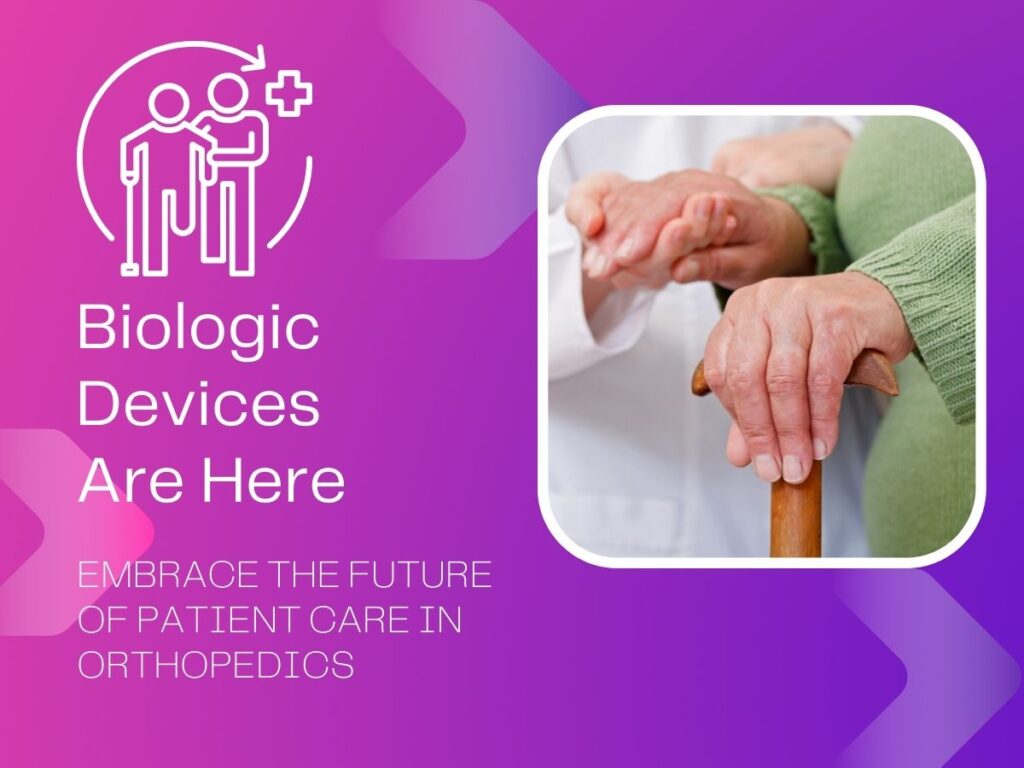Orthopedics has always been at the forefront of medical innovation, focusing on improving mobility, reducing pain, and enhancing the quality of life for millions of people worldwide. From joint replacements to bone regeneration, orthopedic advancements have continuously pushed the boundaries of what’s possible in-patient care. In recent years, Biologic Devices have emerged as a revolutionary force in orthopedics, ushering in a new era of patient care and offering solutions that were once unimaginable.
This blog will explore the current landscape of Orthopedic Devices and Biologic Devices, highlighting their role in improving Joint Replacement, Bone Regeneration, and Patient Mobility. Let’s dive into how these cutting-edge technologies are shaping the future of orthopedic care.
Orthopedic Devices and Biologic Devices: What’s Available Today?
Orthopedic devices have long been a cornerstone of treatment for musculoskeletal conditions, ranging from fractures and ligament tears to full joint replacement surgeries. These devices include a wide range of tools and implants such as plates, screws, rods, and prosthetics. They are designed to support bones, stabilize joints, and improve patient mobility by correcting or replacing damaged structures in the body.
On the other hand, Biologic Devices represent the next frontier in orthopedic care. These devices utilize biologically active substances—such as growth factors, stem cells, and biologic scaffolds—to encourage bone regeneration and tissue healing. By integrating biology with medical technology, Biologic Devices not only provide structural support but also actively promote the body’s natural healing processes.
The combination of Orthopedic Devices and Biologic Devices has created a powerful toolkit for orthopedic surgeons, enabling them to tackle complex issues in ways that weren’t possible before.

Improving Joint Replacement and Patient Mobility
One of the most significant applications of Orthopedic Devices and Biologic Devices is in joint replacement surgeries. Whether it’s a knee, hip, or shoulder, joint replacements are performed when a joint becomes so damaged that it no longer functions properly. Traditional orthopedic implants made from metal, ceramic, or plastic can replace the damaged joint, restoring patient mobility and alleviating pain.
However, these traditional implants come with limitations, such as wear and tear over time, the risk of infection, and the need for revision surgeries. This is where Biologic Devices step in, providing a new level of support. By incorporating biologic components like growth factors or stem cells, Biologic Devices can encourage tissue growth around the implant, improve integration with the body, and reduce the risk of complications. The result is a longer-lasting and more natural joint replacement that significantly enhances patient mobility and reduces recovery time.
Bone Regeneration: The Next Frontier
In addition to improving joint replacements, Biologic Devices are making remarkable strides in bone regeneration. When bones are severely damaged due to trauma or degenerative conditions, simply stabilizing them with plates and screws may not be enough to ensure proper healing. This is where the biologic aspect becomes crucial.
Biologic Devices can introduce substances like bone morphogenetic proteins (BMPs), which stimulate the body to produce new bone tissue. This approach is especially useful in cases where large bone defects exist or where traditional bone grafts may not be effective. By promoting bone regeneration, these devices help ensure that patients regain full mobility after surgery or injury, accelerating their return to daily activities.
The integration of Orthopedic Devices with Biologic Devices in bone healing is transformative. For example, instead of just fixing a fracture with metal rods, surgeons can now add biologics that encourage the bone to heal faster and more robustly. This leads to better outcomes, reduced healing times, and a faster restoration of patient mobility.
How Biologic Devices Are Enhancing Orthopedic Care
The advent of Biologic Devices has revolutionized orthopedic care in ways that were once unthinkable. These devices are particularly effective in the post-surgical recovery process, providing not only structural support but also active healing elements that reduce inflammation, accelerate tissue regeneration, and improve overall outcomes.
For instance, after a joint replacement surgery, Biologic Devices may be used to deliver anti-inflammatory agents or tissue growth stimulators directly to the affected area. This reduces swelling and promotes faster recovery, allowing patients to regain mobility more quickly than with traditional treatments alone.
Furthermore, Biologic Devices have shown promise in treating soft tissue injuries, such as ligament and tendon tears. By using biologic scaffolds and growth factors, these devices support the repair of damaged tissue, making them an invaluable tool in both surgical and non-surgical orthopedic treatments.
The application of Biologic Devices also extends beyond the operating room. Injections of biologic agents, such as ‘Platelet-Rich Plasma (PRP) or stem cells, are now being used to treat chronic conditions like osteoarthritis, helping to regenerate cartilage and alleviate pain. These therapies offer hope to patients who may otherwise face invasive surgeries or long-term disability.
In short, Biologic Devices are enhancing every aspect of orthopedic care, from joint replacements to post-surgical recovery, and even non-invasive treatments for degenerative conditions. The future of orthopedics is clearly moving towards a more holistic approach to healing, with Biologic Devices playing a pivotal role.
FAQs on Orthopedic and Biologic Devices
1. What is the difference between Orthopedic Devices and Biologic Devices?
Orthopedic Devices are mechanical implants like plates, screws, or prosthetics that stabilize or replace damaged joints and bones. Biologic Devices, on the other hand, incorporate biologically active substances like growth factors and stem cells to promote natural healing alongside mechanical support.
2. How do Biologic Devices improve Joint Replacement surgeries?
Biologic Devices improve joint replacements by promoting tissue integration around the implant, reducing complications like infections or implant rejection, and providing a more natural, longer-lasting solution for improved patient mobility.
3. Can Biologic Devices help with Bone Regeneration?
Yes, Biologic Devices are particularly effective in bone regeneration. They release substances like bone morphogenetic proteins that encourage the body to produce new bone tissue, which is crucial for healing large bone defects or fractures.
4. Are Biologic Devices used only in surgery?
No, Biologic Devices can also be used in non-surgical treatments. For instance, biologic injections like PRP or stem cells are used to treat chronic conditions such as osteoarthritis, promoting cartilage regeneration and reducing pain.
5. Are Biologic Devices safe?
Yes, Biologic Devices have undergone extensive testing and are FDA-approved for many applications. They provide a safe and effective way to enhance orthopedic treatments, particularly in joint replacements and bone regeneration.
Conclusion: Embracing a New Era in Orthopedic Care
The rise of Biologic Devices represents a new era in orthopedic care—one that prioritizes not only structural support but also natural healing and regeneration. By integrating the best of traditional Orthopedic Devices with cutting-edge biologics, patients can enjoy faster recovery times, improved patient mobility, and longer-lasting results.
From enhancing joint replacements to accelerating bone regeneration, Biologic Devices are poised to revolutionize how we treat musculoskeletal conditions. If you or a loved one are considering orthopedic surgery or looking for advanced treatments, now is the time to explore the potential of Biologic Devices. This is the future of patient care, and it’s already transforming lives worldwide.
Stay Healthy, Stay Blessed!
